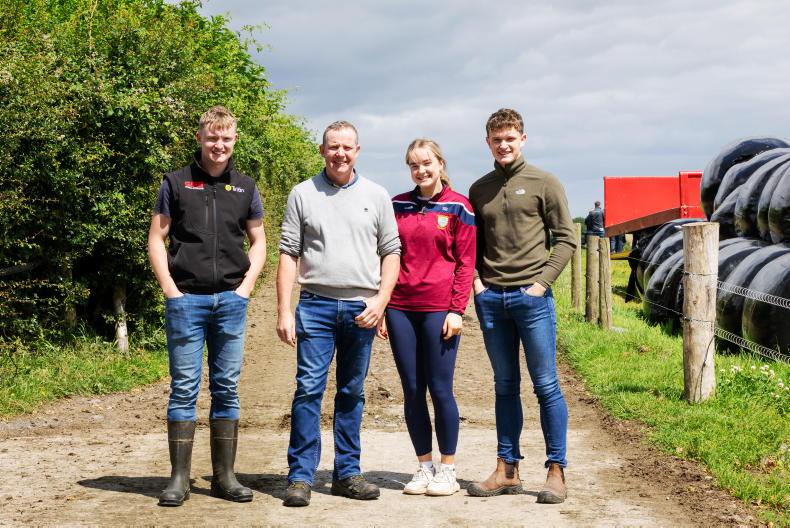Derogation farmers in Timoleague, Co Cork, would have to cut cow numbers by around 20% if the catchment has to move to 220kg of organic nitrogen per hectare (N/ha) under the nitrates derogation, and by 40% if it was lost completely in future, Edward Burgess of Teagasc’s Agricultural Catchments Programme (ACP) has said.
He maintains that overriding factors, such as weather and soil type, can have a greater impact on nitrates losses than whole farm stocking rate, when fertiliser and slurry applications are “sensible” and “timely”.
“Under 250kg, stocking rate has little influence on nitrates loss. Overall farm stocking rate can hide hotspots within the total farm area, and reducing whole farm stocking rate does not necessarily reduce grazing platform stocking rates.”
Even the 220kg/ha derogation could come with “serious pressure” when the next Nitrates Action Programme is being negotiated for 2026 onwards, Burgess told the Irish Farmers Journal.
Farming stakeholders who often only cite 2022’s water quality results for the Timoleague catchment as evidence of improving water quality should be mindful of the catchment’s overarching trends, he warned.
Water trends
Water quality trends have been largely “stable” in the Timoleague catchment, even though 2022 showed up the lowest nitrates concentration leaving the catchment over the ACP’s 13-year long daily monitoring of it, Burgess told the Irish Farmers Journal.
Although it is too early to draw conclusions on this year’s water quality results in Timoleague, current nitrates levels are “over twice what [they were] this time last year”, despite continuing low levels of fertiliser usage, Burgess said.
“Anyone talking on water quality trends needs to be careful that the time period isn’t selected to suit either an agricultural or an environmental narrative.
“On the environmental-side, the Environmental Protection Agency starts at 2012 when nitrates were at their lowest, and stakeholders involved in the dairy industry tend to compare against 2019, when they were at their highest,” he said.
‘Non scientific’
The Teagasc researcher was also critical of the terms of the derogation review, as some of the European Commission’s tests for whether a catchment will have to drop to 220kg N/ha were based solely off a year-on-year comparison of water quality results, labelling such narrow comparisons as being “non scientific”.
When asked if dropping derogation stocking rates from 250kg N/ha to 220kg N/ha would deliver results for water quality, Burgess replied “categorically, no” and warned that the move will “penalise farm income in certain parts of the country”.
Read more
Retaining derogation for 2026 a big challenge - Tánaiste
'We are being portrayed as environmental terrorists'
Hopeful west Cork nitrates results still fall short of water quality targets
Derogation farmers in Timoleague, Co Cork, would have to cut cow numbers by around 20% if the catchment has to move to 220kg of organic nitrogen per hectare (N/ha) under the nitrates derogation, and by 40% if it was lost completely in future, Edward Burgess of Teagasc’s Agricultural Catchments Programme (ACP) has said.
He maintains that overriding factors, such as weather and soil type, can have a greater impact on nitrates losses than whole farm stocking rate, when fertiliser and slurry applications are “sensible” and “timely”.
“Under 250kg, stocking rate has little influence on nitrates loss. Overall farm stocking rate can hide hotspots within the total farm area, and reducing whole farm stocking rate does not necessarily reduce grazing platform stocking rates.”
Even the 220kg/ha derogation could come with “serious pressure” when the next Nitrates Action Programme is being negotiated for 2026 onwards, Burgess told the Irish Farmers Journal.
Farming stakeholders who often only cite 2022’s water quality results for the Timoleague catchment as evidence of improving water quality should be mindful of the catchment’s overarching trends, he warned.
Water trends
Water quality trends have been largely “stable” in the Timoleague catchment, even though 2022 showed up the lowest nitrates concentration leaving the catchment over the ACP’s 13-year long daily monitoring of it, Burgess told the Irish Farmers Journal.
Although it is too early to draw conclusions on this year’s water quality results in Timoleague, current nitrates levels are “over twice what [they were] this time last year”, despite continuing low levels of fertiliser usage, Burgess said.
“Anyone talking on water quality trends needs to be careful that the time period isn’t selected to suit either an agricultural or an environmental narrative.
“On the environmental-side, the Environmental Protection Agency starts at 2012 when nitrates were at their lowest, and stakeholders involved in the dairy industry tend to compare against 2019, when they were at their highest,” he said.
‘Non scientific’
The Teagasc researcher was also critical of the terms of the derogation review, as some of the European Commission’s tests for whether a catchment will have to drop to 220kg N/ha were based solely off a year-on-year comparison of water quality results, labelling such narrow comparisons as being “non scientific”.
When asked if dropping derogation stocking rates from 250kg N/ha to 220kg N/ha would deliver results for water quality, Burgess replied “categorically, no” and warned that the move will “penalise farm income in certain parts of the country”.
Read more
Retaining derogation for 2026 a big challenge - Tánaiste
'We are being portrayed as environmental terrorists'
Hopeful west Cork nitrates results still fall short of water quality targets









SHARING OPTIONS